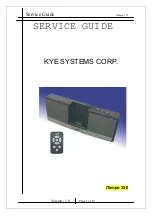
4.
OPTIONAL TWEETER ATTENUATION: There are several reasons for possibly
needing to attenuate the tweeters in the LRS:
1.
Recordings typically in the “pop” or “rock” vein often exhibit a pronounced
rise in the treble region.
2.
The Magneplanar Quasi ribbon tweeter is very e
ffi
cient in it’s total energy
dispersion. If the surrounding walls are exceptionally re
fl
ective, the overall
perceived acoustical balance can be tipped toward a “hot” high end.
3.
Put A and B together and it can be unbearable.
5.
Attenuation is accomplished by placing a resistor in the attenuation position on
the connection plate (see Figure 1 on next page). Provided with your speakers
are 1 and 2 ohm resistors for this purpose. These resistors will provide 1 to 4 dB of
attenuation.
If you continue to have a brightness problem you might consider room
treatment.
6.
ROOM ACOUSTICS: A room that is overly “bright” or “alive” will usually give the
sound a “blurred” or “confused” e
ff
ect. It can also contribute to the brightness
problem mentioned above. On the other hand an overly “dead” room usually
robs the sound of the aliveness and inner detail that can make you “think you are
there.”
You can determine which type of room you have by doing what acoustical
engineers do when they are without their test equipment—they walk around a
room while making an occasional loud clap with their hands. If you do this at
di
ff
erent locations in your room and listen to the sound that bounces back at you
from the room boundaries, you can get a pretty good idea of what your room is
like. If you hear a tailing “zing” after the loud clap, you can be quite certain you
have a “bright” room and you may need to consider some type of wall treatment.
Revised 3/16/2019
Page of
4
5























